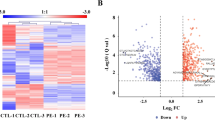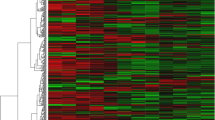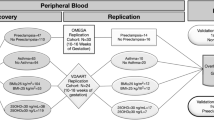Abstract
This study aimed to reveal the key targets and molecular mechanisms of aspirin in preventing preeclampsia. We used bioinformatics databases to collect the candidate targets for aspirin and preeclampsia. The biological functions and signaling pathways of the intersecting targets were analyzed by Gene Ontology (GO) and Kyoto Encyclopedia of Genes and Genomes (KEGG). Then, the hub targets were identified by cytoscape plugin cytoHubba from the protein–protein interaction network. We collected 90 targets for aspirin in preventing preeclampsia. The biological processes of the intersecting targets are mainly involved in xenobiotic metabolic process, inflammatory response, negative regulation of apoptotic process, and protein phosphorylation. The highly enriched pathways were FoxO signaling pathway, circadian rhythm, insulin resistance, arachidonic acid metabolism, and drug metabolism-cytochrome P450. The hub targets for aspirin in preventing preeclampsia were tumor protein p53 (TP53), C–X–C motif chemokine ligand 8 (CXCL8), mitogen-activated protein kinase 3 (MAPK3), mitogen-activated protein kinase 1 (MAPK1), mitogen-activated protein kinase 14 (MAPK14), epidermal growth factor receptor (EGFR), estrogen receptor (ESR1), and prostaglandin-endoperoxide synthase 2 (PTGS2). Molecular docking results showed good bindings between the proteins and aspirin. In conclusion, these findings highlight the key targets and molecular mechanisms of aspirin in preventing preeclampsia.
This is a preview of subscription content, access via your institution
Access options
Subscribe to this journal
Receive 12 digital issues and online access to articles
$119.00 per year
only $9.92 per issue
Buy this article
- Purchase on Springer Link
- Instant access to full article PDF
Prices may be subject to local taxes which are calculated during checkout




Similar content being viewed by others
References
Bearblock E, Aiken CE, Burton GJ. Air pollution and pre-eclampsia; associations and potential mechanisms. Placenta. 2020;104:188–94.
ACOG Committee Opinion No. 743: Low-dose aspirin use during pregnancy. Obstet Gynecol 2018;132:e44–52.
Rolnik DL, Nicolaides KH, Poon LC. Prevention of preeclampsia with aspirin. Am J Obstet Gynecol. 2020; e-pub ahead of print 21 August 2020; https://doi.org/10.1016/j.ajog.2020.08.045
Su MT, Wang CY, Tsai PY, Chen TY, Tsai HL, Kuo PL. Aspirin enhances trophoblast invasion and represses soluble fms-like tyrosine kinase 1 production: a putative mechanism for preventing preeclampsia. J Hypertens. 2019;37:2461–9.
Xu B, Shanmugalingam R, Chau K, Pears S, Hennessy A, Makris A. The effect of acetyl salicylic acid (Aspirin) on trophoblast-endothelial interaction in vitro. J Reprod Immunol. 2017;124:54–61.
Sun J, Zhang H, Liu F, Tang D, Lu X. Ameliorative effects of aspirin against lipopolysaccharide-induced preeclampsia-like symptoms in rats by inhibiting the pro-inflammatory pathway. Can J Physiol Pharm. 2018;96:1084–91.
Zhang X, Gao R, Zhou Z, Tang X, Lin J, Wang L, et al. A network pharmacology based approach for predicting active ingredients and potential mechanism of Lianhuaqingwen capsule in treating COVID-19. Int J Med Sci. 2021;18:1866–76.
Lin L, Li G, Zhang W, Wang YL, Yang H. Low-dose aspirin reduces hypoxia-induced sFlt1 release via the JNK/AP-1 pathway in human trophoblast and endothelial cells. J Cell Physiol. 2019;234:18928–41.
Khanabdali R, Shakouri-Motlagh A, Wilkinson S, Murthi P, Georgiou HM, Brennecke SP, et al. Low-dose aspirin treatment enhances the adhesion of preeclamptic decidual mesenchymal stem/stromal cells and reduces their production of pro-inflammatory cytokines. J Mol Med. 2018;96:1215–25.
Li Y, Zhou C, Lei W, Wang K, Zheng J. Roles of aryl hydrocarbon receptor in endothelial angiogenic responsesdagger. Biol Reprod. 2020;103:927–37.
Slonchak AM, Martseniuk OP, Rzeszowska-Wolny J, Vidlak P, Obolens’ka M. [Some aspects of glutathione S-transferase P1-1 gene transcription regulation in human placenta]. Ukr Biokhim Zh 1999;2007;79:67–75.
Huang Q, Hu B, Han X, Yang J, Di X, Bao J, et al. Cyclosporin A ameliorates eclampsia seizure through reducing systemic inflammation in an eclampsia-like rat model. Hypertension Res. 2020;43:263–70.
Huai J, Li GL, Lin L, Ma JM, Yang HX. Phosphoproteomics reveals the apoptotic regulation of aspirin in the placenta of preeclampsia-like mice. Am J Transl Res. 2020;12:3361–3375.
Panagodage S, Yong HE, Da Silva Costa F, Borg AJ, Kalionis B, Brennecke SP, et al. Low-dose acetylsalicylic acid treatment modulates the production of cytokines and improves trophoblast function in an in vitro model of early-onset preeclampsia. Am J Pathol. 2016;186:3217–3224.
Pai CH, Yen CT, Chen CP, Yu IS, Lin SW, Lin SR. Lack of thromboxane synthase prevents hypertension and fetal growth restriction after high salt treatment during pregnancy. PloS One. 2016;11:e0151617.
Sheridan R, Belludi C, Khoury J, Stanek J, Handwerger S. FOXO1 expression in villous trophoblast of preeclampsia and fetal growth restriction placentas. Histol Histopathol. 2015;30:213–22.
Al-Far HFM, Tjessem IH, Fuglsang J, Lauszus FF. Preeclampsia is associated with increased ambulatory arterial stiffness index in type 1 diabetes mellitus. Eur J Obstet, Gynecol, Reprod Biol. 2017;216:153–8.
Ayala DE, Ucieda R, Hermida RC. Chronotherapy with low-dose aspirin for prevention of complications in pregnancy. Chronobiol Int. 2013;30:260–79.
Gairard A, Lopez-Miranda V, Pernot F, Beck JF, Coumaros G, Van Overloop B, et al. Effect of i1 imidazoline receptor agonist, moxonidine, in nitric oxide-deficient hypertension in pregnant rats. J Cardiovascular Pharmacol. 2004;43:731–736.
Plenty NL, Faulkner JL, Cotton J, Spencer SK, Wallace K, LaMarca B, et al. Arachidonic acid metabolites of CYP4A and CYP4F are altered in women with preeclampsia. Prostaglandins Other Lipid Mediat. 2018;136:15–22.
Mistry HD, Kurlak LO, Mansour YT, Zurkinden L, Mohaupt MG, Escher G. Increased maternal and fetal cholesterol efflux capacity and placental CYP27A1 expression in preeclampsia. J Lipid Res. 2017;58:1186–95.
Herse F, LaMarca BB, Hubel CA, Laivuori H, Huppertz B, Verlohren S, et al. OS066. Intrauterine CYP2J2 expression and circulating epoxyeicosatrienoic acid levels in preeclampsia. Pregnancy Hypertens. 2012;2:212–3.
Harati-Sadegh M, Kohan L, Teimoori B, Mehrabani M, Salimi S. Analysis of polymorphisms, promoter methylation, and mRNA expression profile of maternal and placental P53 and P21 genes in preeclamptic and normotensive pregnant women. J Biomed Sci. 2019;26:92.
Jiang R, Wang T, Zhou F, Yao Y, He J, Xu D. Bioinformatics-based identification of miRNA-, lncRNA-, and mRNA-associated ceRNA networks and potential biomarkers for preeclampsia. Medicine. 2020;99:e22985.
Moon KC, Park JS, Norwitz ER, Kim DI, Oh KJ, Park CW, et al. Expression of extracellular signal-regulated kinase1/2 and p38 mitogen-activated protein kinase in the invasive trophoblasts at the human placental bed. Placenta. 2008;29:391–5.
Su YF, Yang SH, Lee YH, Wu BC, Huang SC, Liu CM, et al. Aspirin-induced inhibition of adipogenesis was p53-dependent and associated with inactivation of pentose phosphate pathway. Eur J Pharmacol. 2014;738:101–10.
Li FH, Han N, Wang Y, Xu Q. Gadd45a knockdown alleviates oxidative stress through suppressing the p38 MAPK signaling pathway in the pathogenesis of preeclampsia. Placenta. 2018;65:20–28.
Fan M, Li X, Gao X, Dong L, Xin G, Chen L, et al. LPS induces preeclampsia-like phenotype in rats and HTR8/SVneo cells dysfunction through TLR4/p38 MAPK pathway. Front Physiol. 2019;10:1030.
Castro P, Nasser H, Abrahao A, Dos Reis LC, Rica I, Valenca SS, et al. Aspirin and indomethacin reduce lung inflammation of mice exposed to cigarette smoke. Biochemical Pharmacol. 2009;77:1029–39.
Hastie R, Brownfoot FC, Pritchard N, Hannan NJ, Cannon P, Nguyen V, et al. EGFR (Epidermal growth factor receptor) signaling and the mitochondria regulate sFlt-1 (soluble FMS-like tyrosine kinase-1) secretion. Hypertension. 2019;73:659–70.
Bashir AIJ, Kankipati CS, Jones S, Newman RM, Safrany ST, Perry CJ, et al. A novel mechanism for the anticancer activity of aspirin and salicylates. Int J Oncol. 2019;54:1256–70.
Lan KC, Lai YJ, Cheng HH, Tsai NC, Su YT, Tsai CC, et al. Levels of sex steroid hormones and their receptors in women with preeclampsia. Reprod Biol Endocrinol. 2020;18:12.
Goksu Erol AY, Nazli M, Yildiz SE. Expression levels of cyclooxygenase-2, tumor necrosis factor-alpha and inducible NO synthase in placental tissue of normal and preeclamptic pregnancies. J Matern Fetal Neonatal Med. 2012;25:826–30.
Reijnders D, Liu CC, Xu X, Zhao AM, Olson KN, Butler SD, et al. Celecoxib restores angiogenic factor expression at the maternal-fetal interface in the BPH/5 mouse model of preeclampsia. Physiol Genom. 2018;50:385–92.
Altinoz MA, Korkmaz R. NF-kappaB, macrophage migration inhibitory factor and cyclooxygenase-inhibitions as likely mechanisms behind the acetaminophen- and NSAID-prevention of the ovarian cancer. Neoplasma. 2004;51:239–47.
Funding
This work was supported by National Natural Science Foundation of China (No. 81903696 to Jiejie Zhang; No. 81974236 to Weishe Zhang) and Postdoctoral Foundation of Xiangya Hospital Central South University (No. 2209090555067 to Jiejie Zhang).
Author information
Authors and Affiliations
Contributions
Jiejie Zhang and Jingrui Huang analyzed the data. Jiejie Zhang drafted the paper. Yanhua Zhao and Weishe Zhang were responsible for design and co-ordination of the project and preparation of the manuscript. All authors reviewed and approved submission of the manuscript.
Corresponding author
Ethics declarations
Competing interests
The authors declare no competing interests.
Additional information
Publisher’s note Springer Nature remains neutral with regard to jurisdictional claims in published maps and institutional affiliations.
Rights and permissions
About this article
Cite this article
Zhang, J., Huang, J., Zhao, Y. et al. The preventive effects of aspirin on preeclampsia based on network pharmacology and bioinformatics. J Hum Hypertens 36, 753–759 (2022). https://doi.org/10.1038/s41371-021-00568-7
Received:
Revised:
Accepted:
Published:
Issue Date:
DOI: https://doi.org/10.1038/s41371-021-00568-7



